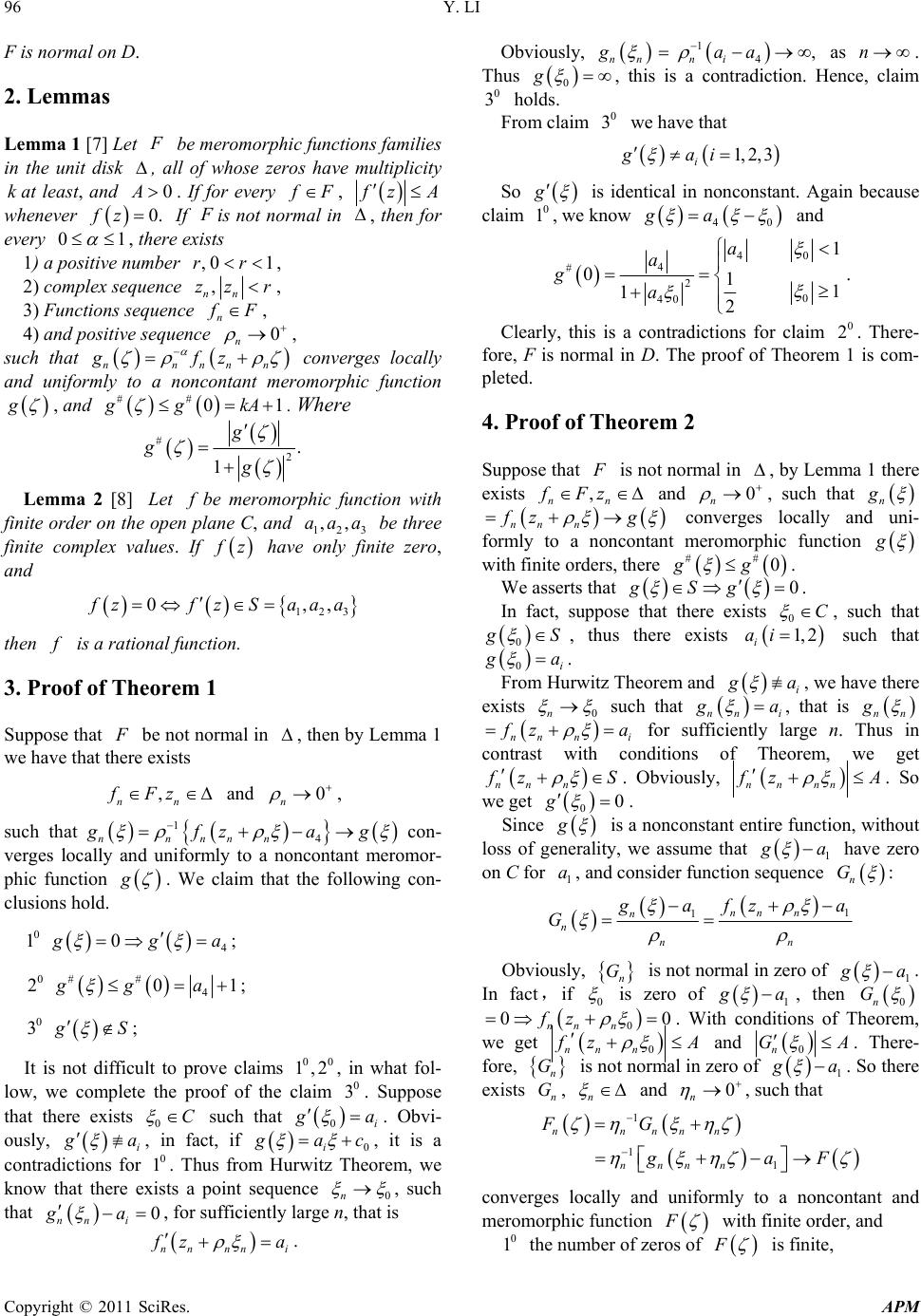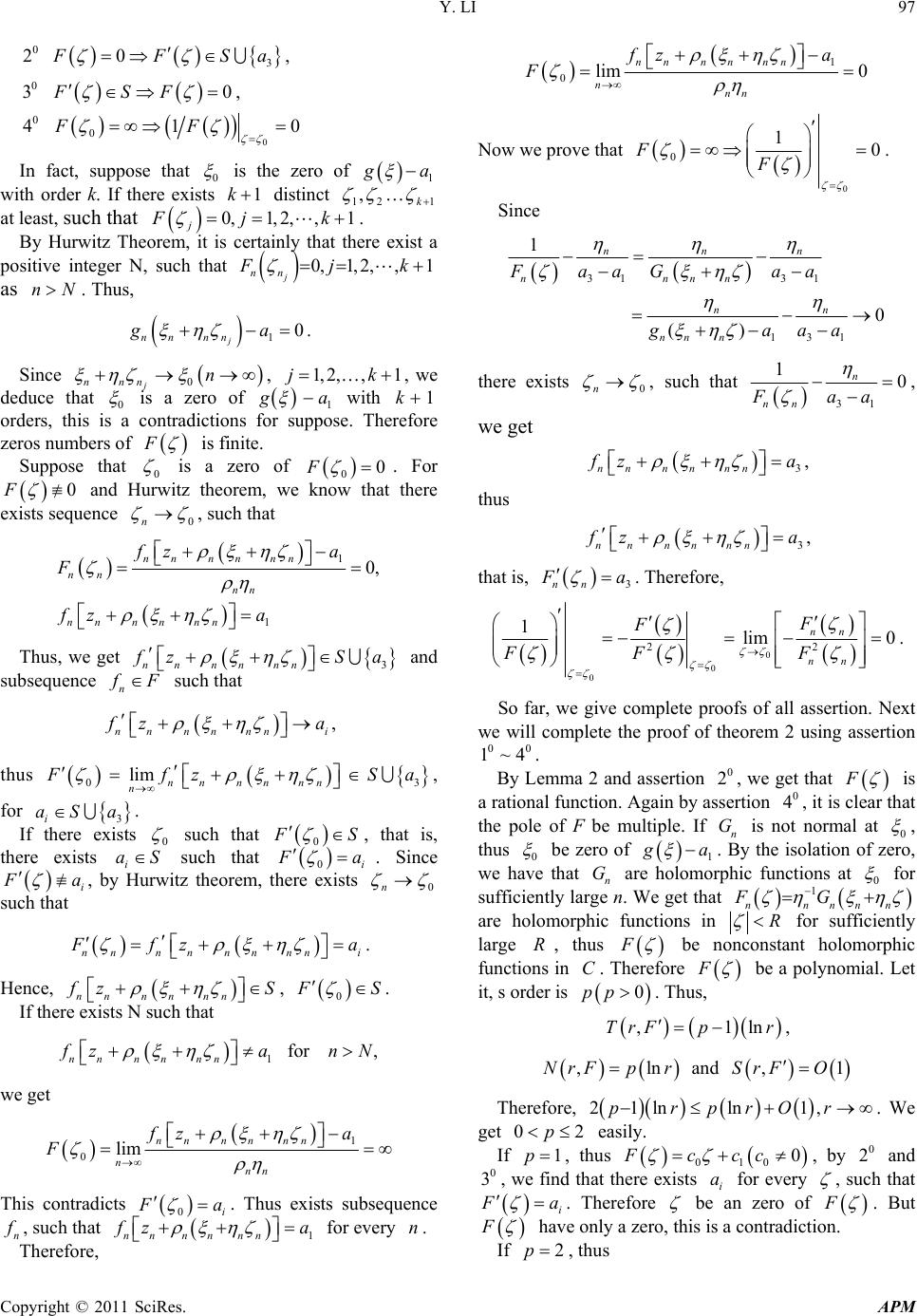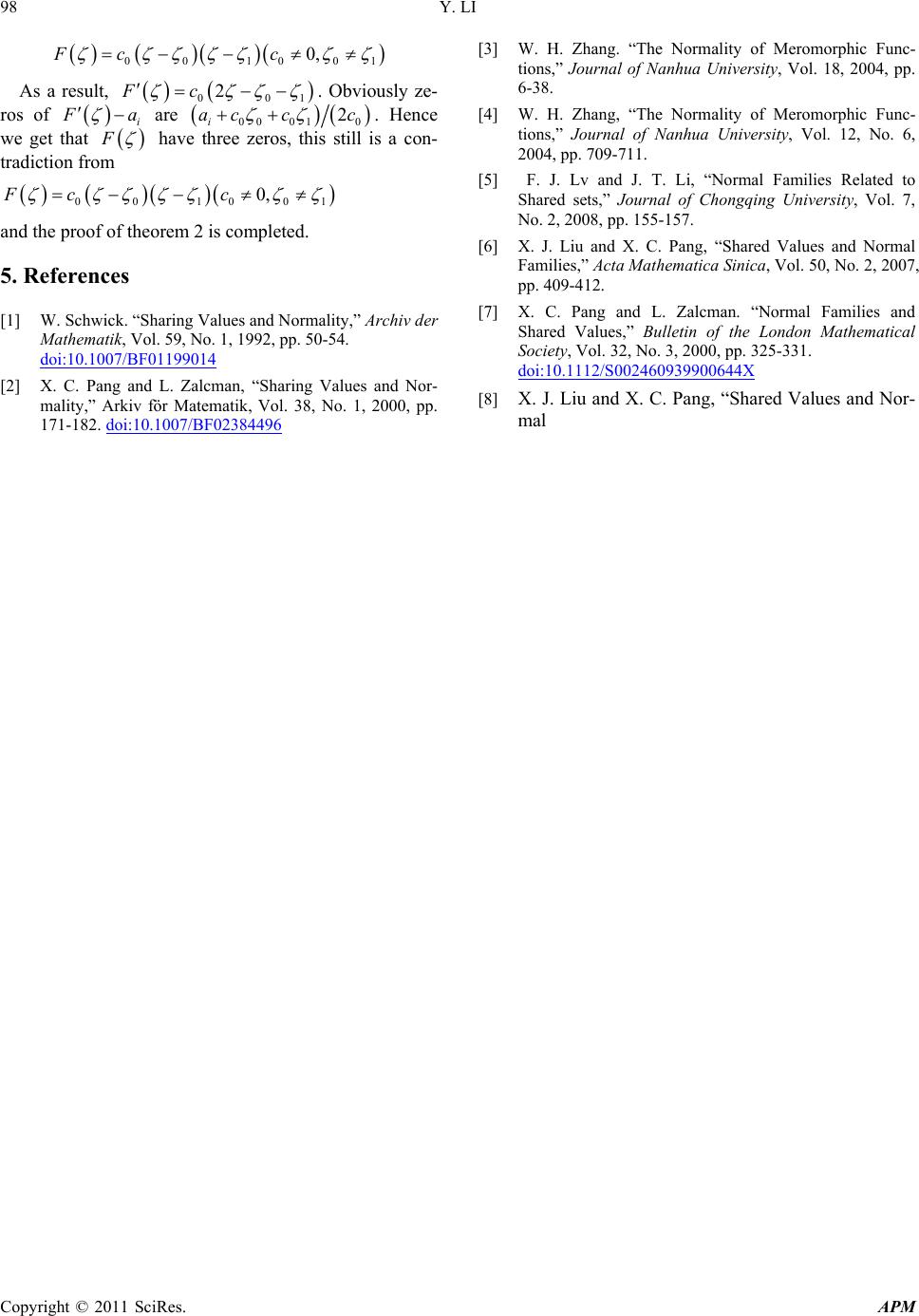Paper Menu >>
Journal Menu >>
 Advances in Pure Mathematics, 2011, 1, 95-98 doi:10.4236/apm.2011.13021 Published Online May 2011 (http://www.scirp.org/journal/apm) Copyright © 2011 SciRes. APM Normality of Meromorphic Functions Family and Shared Set by One-way Yi Li School of Science, Southw est Universi ty of Scie nce a nd Te chn olo gy, Mianyang, Chin a, E-mail: liyi@swust.edu.cn Received March 16, 201 1; revised April 5, 2011; accepted April 10, 2011 Abstract We studied the normality criterion for families of meromorphic functions which related to One-way sharing set, and obtain two normal criterions, which improve the previous results. Keywords: Meromorphic Function, Normality Criterion, Shared Values, Shared Set by One-way 1. Introduction For Shared values, Schwick proved the following result [1]: Theorem A Let F be a family of meromorphic func- tions in the domain D, 1 a, 2 a and 3 a be three finite complex numbers. If for every ,1,2,3 fi fi fFEa Eai then F is normal in D. In 2000, Pang Xue-cheng and Zalcman generalized the Schwick’s result [2]: Theorem B Let F be meromorphic functions family in the domain D, and 1 a, 2 a be two complex number. If for every ,1,2 fi fi fFEa Eai then F is normal in D. Definition For ,ab are two distinct complex values, we have set ,Sab and , :0, ff ES Eab z fzafzbz D If fg ES ES, we call that f and g share S in D; If fg ES ES, we call that f and g share S by One-way in D. For shared set, W. H. Zhang obtained impor tant results [3]: Theorem C Let F be a family of meromorphic func- tions in the unit di sc , a and b be two distinct nonzero complex value, ,Sab, If for every f F, all of whose zeros is multiple, ff ES ES , then F is normal on . W. H. Zhang continued considering the relation be- tween normality and the shared set, and proved the next result [4]: Theorem D Let F be meromorphic functions family in the unit disk , a and b be two distinct nonzero com- plex values. If for every fF, all of whose zeros is multiplicity 1k at least (k is a positive integer), kf f ESES, then F is normal in . For shared set by One-way, Lv Feng-jiao got follow- ing theorem in [5]: Theorem E Let F be a family of meromorphic func- tion in the unit disk , a and b is two distinct nonzero complex values, kis positive integer, ,Sab. If for every f F , all of whose zeros have multiplicity 1k at least, kf f ESES, then F is normal in . In 2007, Pang Xue-cheng proved the following im- portant results in [6]: Theorem F Let F be meromorphic functions family in D, 123 ,,Saaa. If for every f F ff ES ES , then F is normal on D. To promote the results of Pang Xue-cheng, we con- tinue to discuss about normality theorem of meromorphic functions families concerning shared set and shared set by one-way, and obtain our main results as follow. Theorem 1 Let F be meromorphic functions fami- lies in D, 123 4 ,, ,i Saaaaa (i = 1, 2, 3). If for every f F , ff ES ES , and 4 f a whenever 4 f a , then F is normal on D. Theorem 2 Let F be meromorphic functions fami- lies in D, 12 3 ,,SaaaC . If for every f F , ff ES ES , and 3 f a , whenever 3 f a , then  Y. LI Copyright © 2011 SciRes. APM 96 F is normal on D. 2. Lemmas Lemma 1 [7] Let F be meromorphic functions families in the unit disk , all of whose zeros have multiplicity kat least, and 0A. If for every f F, f zA whenever 0.fz If F is not normal in , then for every 01 , there exists 1) a positive number ,0 1rr, 2) complex sequence , nn zz r, 3) Functions sequence n f F, 4) and positive sequence 0 n , such that nnnnn gfz converges locally and uniformly to a noncontant meromorphic function g , and ## 01ggkA . Where # 2. 1 g gg Lemma 2 [8] Let f be meromorphic function with finite order on the open plane C, and 123 ,,aaa be three finite complex values. If f z have only finite zero, and 123 0,, f zfzSaaa then f is a rational function. 3. Proof of Theorem 1 Suppose that F be no t normal in , then by Lemma 1 we have that there exists ,and0 nn n fFz , such that 14nnnnn gfzag con- verges locally and uniformly to a noncontant meromor- phic function g . We claim that the following con- clusions hold. 04 10 g ga ; 0## 4 201gga ; 0 3 g S ; It is not difficult to prove claims 00 1,2, in what fol- low, we complete the proof of the claim 0 3. Suppose that there exists 0C such that 0i g a . Obvi- ously, i g a , in fact, if 0i g ac , it is a contradictions for 0 1. Thus from Hurwitz Theorem, we know that there exists a point sequence 0n , such that 0 nn i ga , for sufficiently large n, that is nn nni f za . Obviously, 14, nnn i gaa as n. Thus 0 g , this is a contradiction. Hence, claim 0 3 holds. From claim 0 3 we have that 1,2,3 i gai So g is identical in nonconstant. Again because claim 0 1, we know 40 ga and 40 4 #20 40 1 011 12 a a ga . Clearly, this is a contradictions for claim 0 2. There- fore, F is normal in D. The proof of Theorem 1 is com- pleted. 4. Proof of Theorem 2 Suppose that F is not normal in , by Lemma 1 there exists , nn fFz and 0 n , such that n g nn n fz g converges locally and uni- formly to a noncontant meromorphic function g with finite orders, there ## 0gg . We asserts that 0gSg . In fact, suppose that there exists 0C , such that 0 g S , thus there exists 1, 2 i ai such that 0i g a . From Hurwitz Theor em and i g a , we have there exists 0n such that nni g a , that is nn g nn ni f za for sufficiently large n. Thus in contrast with conditions of Theorem, we get nn n f zS . Obviously, nn nn f zA . So we get 00g . Since g is a nonconstan t entire function, without loss of generality, we assume that 1 g a have zero on C for 1 a, and consider function sequence n G : 1 1nnn n nnn f za ga G Obviously, n G is not normal in zero of 1 g a . In fact,if 0 is zero of 1 g a , then 0n G 0 00 nn n fz . With conditions of Theorem, we get 0nn n f zA and 0n GA . There- fore, n G is not normal in zero of 1 g a . So there exists n G, n and 0 n , such that 1 11 nnnnn nnnn FG gaF converges locally and uniformly to a noncontant and meromorphic function F with finite order, and 0 1 the number of zeros of F is finite,  Y. LI Copyright © 2011 SciRes. APM 97 03 20 F FSa , 0 30FSF , 0 00 410FF In fact, suppose that 0 is the zero of 1 g a with order k. If there exists 1k distinct 121 ,k at least, such that 0,1,2, ,1 j F jk . By Hurwitz Theorem, it is certainly that there exist a positive integer N, such that 0, 1,2, ,1 j nn F jk as nN. Thus, 10 j nn nn ga . Since 0 j nnn n , 1, 2,,1jk, we deduce that 0 is a zero of 1 g a with 1k orders, this is a contradictions for suppose. Therefore zeros numbers of F is finite. Suppose that 0 is a zero of 00F . For 0F and Hurwitz theorem, we know that there exists sequence 0n , such that 1 1 0, nnnn nn nn nn nnnn nn fz a F fz a Thus, we get 3nnnn nn fzS a and subsequence n fF such that nnnn nni fz a , thus 03 lim nnnn nn n F fzS a , for 3i aS a. If there exists 0 such that 0 F S , that is, there exists i aS such that 0i F a . Since i F a , by Hurwitz theorem, there exists 0n such that nnn nnnnni F fz a . Hence, nnnn nn fz S , 0 F S . If there exists N such that 1for , nnnn nn fza nN we get 1 0lim nnnnnn nnn fz a F This contradicts 0i F a . Thus exists subsequence n f, such that 1nnnn nn fz a for every n. Therefore, 1 0lim 0 nnnnnn nnn fz a F Now we prove that 0 010FF . Since 31 31 131 1 0 () nnn nnnn nn nn n FaaGaa gaaa there exists 0n , such that 31 10 n nn Faa , we get 3nnnn nn f za , thus 3nnnn nn f za , that is, 3nn F a . Therefore, 0 0 0 22 1lim 0 nn nn F F FFF . So far, we give complete proofs of all assertion. Next we will complete the proof of theorem 2 using assertion 00 1~4. By Lemma 2 and assertion 0 2, we get that F is a rational function. Again by assertion 0 4, it is clear that the pole of F be multiple. If n G is not normal at 0 , thus 0 be zero of 1 g a . By the isolation of zero, we have that n G are holomorphic functions at 0 for sufficiently large n. We get that 1 nnnnn FG are holomorphic functions in R for sufficiently large R, thus F be nonconstant holomorphic functions in C. Therefo re F be a polynomial. Let it, s order is 0pp. Thus, ,1lnTrF pr , ,lnand, 1NrFprSrFO Therefore, 21lnln 1,prprOr . We get 02p easily. If 1p , thus 010 0Fccc , by 0 2 and 0 3, we find that there exists i a for every , such that i F a . Therefore be an zero of F . But F have only a zero, this is a contradiction. If 2p , thus  Y. LI Copyright © 2011 SciRes. APM 98 00 1001 0,Fc c As a result, 001 2Fc . Obviously ze- ros of i F a are 00 010 2 i ac cc . Hence we get that F have three zeros, this still is a con- tradiction from 00 1001 0,Fc c and the proof of theorem 2 is completed. 5. References [1] W. Schwick. “Sharing Values and Normality,” Archiv der Mathematik, Vol. 59, No. 1, 1992, pp. 50-54. doi:10.1007/BF01199014 [2] X. C. Pang and L. Zalcman, “Sharing Values and Nor- mality,” Arkiv för Matematik, Vol. 38, No. 1, 2000, pp. 171-182. doi:10.1007/BF02384496 [3] W. H. Zhang. “The Normality of Meromorphic Func- tions,” Journal of Nanhua University, Vol. 18, 2004, pp. 6-38. [4] W. H. Zhang, “The Normality of Meromorphic Func- tions,” Journal of Nanhua University, Vol. 12, No. 6, 2004, pp. 709-711. [5] F. J. Lv and J. T. Li, “Normal Families Related to Shared sets,” Journal of Chongqing University, Vol. 7, No. 2, 2008, pp. 155-157. [6] X. J. Liu and X. C. Pang, “Shared Values and Normal Families,” Acta Mathematica Sinica, Vol. 50, No. 2, 2007, pp. 409-412. [7] X. C. Pang and L. Zalcman. “Normal Families and Shared Values,” Bulletin of the London Mathematical Society, Vol. 32, No. 3, 2000, pp. 325-331. doi:10.1112/S002460939900644X [8] X. J. Liu and X. C. Pang, “Shared Values and Nor- mal |

